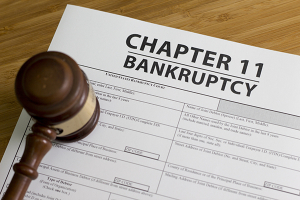Chapter 11 Corporate Bankruptcy
Many times a corporate Chapter 11 bankruptcy debtor proceeding through the reorganization process has liabilities that bind directors and officers. For example, a director or officer may have signed a guaranty in favor of a creditor or a credit application which many times have hidden guaranty clauses for the individual signing the credit application. In some instances, corporate credit cards may convey potential liability to the directors or officers making the credit card purchase. Quite often, the directors and officers are essential in the reorganization process for the corporate debtor.
To maximize the success of the corporate reorganization, it is important that the directors and officers be free from litigation involving corporate debt so that the focus is on the reorganization process. Abandonment by the directors and officers of the corporate debtor during the reorganization process resulting in dismissal or liquidation may not be in the best interest of the creditors.
The Eleventh Circuit addressed the issue of director and officer releases in In re Seaside Engineering & Surveying, Inc., 780 F.3d 1070, 1079-1082 (11th Cir. 2015), the Eleventh Circuit adopted the majority position that non-debtor releases are permitted as long as a seven factor test is met. These factors include: 1) the identity of the interests between debtor and third party and whether the suit against third party is in essence a suit against the debtor; 2) whether the non-debtor has contributed substantial assets to the debtor; 3) whether reorganization hinges on debtor being free from indirect suits; 4) whether the impacted class has accepted the plan; 4) whether the plan has a mechanism to pay all or substantially all of the classes affected; 5) whether the plan provides an opportunity for claimants who do not accept to recover in full; and 6) the record of the factual findings in support of the factors. When applying the aforementioned factors, care should be given to ensure notice to the affected creditors.
The value of avoiding further litigation or personal bankruptcies for the directors and officers is obvious when the main goal is achieving a successful reorganization for the corporate debtor. Further litigation for the directors and officers would result in the needless expenditure of funds that could be better used in the reorganization process. Furthermore, the credit of the directors and officers will be necessary for the acquisition of inventory, supplies and payment of incidental expenses of the reorganized debtor and may be necessary to fund the plan of reorganization through new financing.
It is the directors and officers that are the lifeblood of the corporate debtor and their contributions of time, effort and money, without compensation many times, should not go unnoticed to creditors. It is better that this time, effort and money be spent on the reorganization process than on individual creditor disputes that are primarily based on the corporate debtor’s liability. Having directors and officers focused on the retention of business, operations, growth and profitability is where the effort needs to be. A savvy creditor that understands the utility of the third party release can ensure the success of the reorganized debtor, can become involved in the reorganization process of the debtor and can structure a profitable business relationship with the debtor for the future that is beneficial to both debtor and creditor.
By Richard R. Robles, Esquire
Law Offices of Richard R. Robles, P.A.
905 Brickell Bay Drive, Suite 228
Miami, Florida 33131
(305) 755-9200
[email protected]


